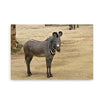Where to sell your photographs? Discover the best platforms!
When we think of selling photographs, the image that often comes to mind is that of elegant art galleries, with their white walls adorned with carefully framed works. These spaces, dedicated to art in all its forms, have long been the main sales channel for photographers. But how do they work, and are they suitable for all photographers?
The prestige of art galleries
Selling your photos in an art gallery is often seen as a sign of professional recognition. It is the opportunity to present your work in a dedicated environment, where art lovers come specifically to discover and purchase works. Being exhibited in such a gallery can greatly contribute to a photographer's notoriety.
How to be represented by a gallery?
The process for being represented by an art gallery can vary, but it generally involves careful selection. Galleries are looking for artists whose work is not only of high quality, but also in line with their editorial line. It is therefore essential to choose the galleries you approach carefully and present them with a solid and coherent portfolio.
The advantages and disadvantages
Advantages :
- Visibility to a targeted and often wealthy audience.
- Possibility of organizing openings and meetings with art lovers.
- Professional recognition.
Disadvantages :
- Commissions taken by galleries can be high, thereby reducing the artist's net income.
- Competition is tough, and it is not always easy to be selected by a prestigious gallery.
- Need to have a stock of works ready to be sold.
Online platforms: the digital era for selling your photos
With the advent of the digital age, the world of photography has undergone a revolution. Online platforms now offer photographers a multitude of opportunities to sell their works to a global audience. Let's discover together the advantages, disadvantages and some popular platforms for selling your photos online .
Why choose an online platform?
1. Accessibility : Online platforms are accessible 24/7, allowing buyers around the world to discover and purchase photos at any time.
2. Large audience : Unlike traditional galleries which may be limited geographically, online platforms reach an international audience.
3. Flexibility : Photographers can update their portfolio in real time, add or remove photos as they wish.
Some popular platforms
1. Shutterstock and Getty Images : These stock photography giants offer unparalleled visibility, but can take a significant commission on sales.
2. The French poster shop : This platform stands out for its specialization in the sale of photos in the form of posters. It promotes the work of artists and offers an optimal user experience for those who wish to sell their photos.
3. Etsy and Redbubble : Although not exclusively dedicated to photography, these platforms allow artists to sell their photos in different formats, from simple prints to merchandise.
The advantages and disadvantages of online platforms
Advantages :
- Ease of use and quick setup.
- Possibility of reaching a large audience.
- Flexibility in managing your portfolio.
Disadvantages :
- Competition is fierce, with millions of photos available.
- Commissions can be high on some platforms.
- Need for active promotion to stand out.
Art fairs and shows: direct interaction to sell your photos
Art fairs and salons are events where artists, collectors, gallery owners and art lovers come together to celebrate creativity. For a photographer, participating in such events can provide a unique opportunity to sell their photos while making valuable connections in the art world.
The importance of art fairs and shows
1. Immediate visibility : Fairs and exhibitions generally attract a large number of visitors, providing instant visibility for your work.
2. Direct interaction : Unlike online sales, fairs allow direct interaction with the public. This is an opportunity to explain your approach, receive immediate feedback and understand buyers' expectations.
3. Networking : These events are perfect for connecting with other artists, gallery owners or collectors. They can open doors to future collaborations or sales opportunities.
How to prepare well?
1. Select the right fairs : Not all fairs are equal. Look for the ones that best suit your style and target audience.
2. Present a strong portfolio : Make sure you have a consistent, high-quality photo selection. Also think about how you are going to present them: framing, layout, etc.
3. Be prepared to chat : Visitors will ask questions about your work. Be ready to talk about your approach, your inspirations and your technique.
The advantages and disadvantages of fairs and exhibitions
Advantages :
- Direct interaction with the public.
- Networking opportunities.
- Immediate visibility.
Disadvantages :
- Cost of participation sometimes high.
- Need for significant logistics (transport of works, installation, etc.).
- Competition can be tough, especially at big fairs.
Social networks: a showcase for his work
Although social networks are not sales platforms strictly speaking, they can be used as a showcase for one's work. Instagram, in particular, is very popular with photographers. By building a strong community, you will be able to direct your subscribers to your site or online store.
In conclusion: selling your photos, an adventure within reach
Selling your photos is more accessible than ever. Whether you opt for a traditional art gallery, an online platform like La boutique du poster français, or whether you decide to create your own site, the opportunities are numerous. With perseverance, quality and a good marketing strategy, you will be able to profit from your passion and make a living from your art. So, are you ready to sell your photos to the world?






































































Leave a comment
All comments are moderated before being published.
This site is protected by hCaptcha and the hCaptcha Privacy Policy and Terms of Service apply.